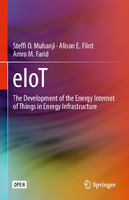eIoT
The Development of the Energy Internet of Things in Energy Infrastructure
Author(s)
Muhanji, Steffi O.
Flint, Alison E.
Farid, Amro M.
Language
EnglishAbstract
This open access book explores the collision between the sustainable energy transition and the Internet of Things (IoT). In that regard, this book’s arrival is timely. Not only is the Internet of Things for energy applications, herein called the energy Internet of Things (eIoT), rapidly developing but also the transition towards sustainable energy to abate global climate is very much at the forefront of public discourse. It is within the context of these two dynamic thrusts, digitization and global climate change, that the energy industry sees itself undergoing significant change in how it is operated and managed. This book recognizes that they impose five fundamental energy management change drivers: 1.) the growing demand for electricity, 2.) the emergence of renewable energy resources, 3.) the emergence of electrified transportation, 4.) the deregulation of electric power markets, 5.) and innovations in smart grid technology. Together, they challenge many of the assumptions upon which the electric grid was first built. The goal of this book is to provide a single integrated picture of how eIoT can come to transform our energy infrastructure. This book links the energy management change drivers mentioned above to the need for a technical energy management solution. It, then, describes how eIoT meets many of the criteria required for such a technical solution. In that regard, the book stresses the ability of eIoT to add sensing, decision-making, and actuation capabilities to millions or perhaps even billions of interacting “smart" devices. With such a large scale transformation composed of so many independent actions, the book also organizes the discussion into a single multi-layer energy management control loop structure. Consequently, much attention is given to not just network-enabled physical devices but also communication networks, distributed control & decision making, and finally technical architectures and standards. Having gone into the detail of these many simultaneously developing technologies, the book returns to how these technologies when integrated form new applications for transactive energy. In that regard, it highlights several eIoT-enabled energy management use cases that fundamentally change the relationship between end users, utilities, and grid operators. Consequently, the book discusses some of the emerging applications for utilities, industry, commerce, and residences. The book concludes that these eIoT applications will transform today’s grid into one that is much more responsive, dynamic, adaptive and flexible. It also concludes that this transformation will bring about new challenges and opportunities for the cyber-physical-economic performance of the grid and the business models of its increasingly growing number of participants and stakeholders.
Keywords
Energy; Renewable energy resources; Energy systems; Power electronics; Electrical engineering; Application softwareDOI
10.1007/978-3-030-10427-6Publisher
Springer NaturePublisher website
https://www.springernature.com/gp/products/booksPublication date and place
Cham, 2019Classification
Energy technology and engineering
Electrical engineering
Alternative and renewable energy sources and technology
Communications engineering / telecommunications
Information retrieval


 Download
Download Web Shop
Web Shop